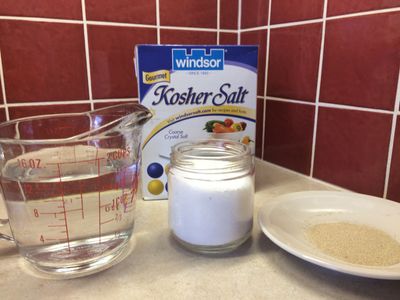This is the third post in our Learning Loaf series. Lesson 1 discussed the basic bread baker's toolkit. Lesson 2 was all about flour. Today it's all about the 3 other ingredients that make up an awesome loaf of homemade bread.
All Great Bread is Based on Four Ingredients #
Flour. Water. Salt. Yeast. That's it.
Now the sourdough guys would just name the first three, but what's in the sourdough culture? Yeast of course!
In the last lesson, I talked about the first main ingredient, flour. For many people, picking the right flour can be scary. The "Other 3" ingredients are a little simpler to figure out.

The 'Other 3' ingredients: water, salt and yeast.
Water #
I recommend using organic, free range Himalayan yak water in all your baking.
Not.
I use tap water. If your tap water is safe to drink, go ahead and use it.
The main thing you're going to worry about with water is temperature. You want your dough to be a good temperature for fermentation (around 24C / 75F) and you have the most control over water temperature. That means in winter you'll be using warm water (27C / 80F or more) and in summer, cool water (18C / 65F or even less)
At the bakery, when we were mixing large batches of dough in a drafty room with room temperature flour, our water temperatures would swing between 10C/50F in summer and 32C/90F in winter and our dough always came out at a perfect (for sourdough) 26C/78F. Strange but true.
TIP: If you don't have a thermometer, use your finger! Go for water that feels just barely "not cold" to the touch if you're in a warm room, or just skin temperature if you're in a cold room. You'll be fine.
Salt #
This is another ingredient that you can go crazy with but it's unnecessary. Save your pink Himalayan sea salt for other uses. Plain old salt from the ground around Chaplin, Saskatchewan is just fine. And hey, it's local!
The only thing to avoid, if you can, is iodized table salt. No need for iodine in your bread.
I tend towards salt that's labelled "kosher salt" because it doesn't have iodine added.
Yeast #
The best yeast to buy for home bakers is instant dry yeast. You can tell you have the right stuff because the specks of yeast are very fine, smaller than flaky salt. Instant yeast is dried using the most modern techniques so you'll get way more live yeast cells per gram of yeast. It keeps for a long time in an airtight container and is cheap. Plus (and this is great!) you can mix it into your flour dry, without going through a "proving" step.
You'll also see "active dry yeast" in the stores. Avoid it. This is yeast dried using old technology. The granules in active dry yeast are larger than instant yeast - they're bigger because a lot more of the yeast cells in the granule are already dead. You'll need to "prove" active dry yeast in water to see that the yeast is alive. It's a waste of time and effort - just get instant yeast.
Fresh yeast is romantic, but again, not necessary. Found in 1 pound cakes, this is yeast that has been compressed but not dried. It has a short shelf life and must be kept in the refrigerator. Unless you are baking a lot, it's not worth the hassle. Besides, we don't use a lot of yeast in our bread, because we want the bread to develop flavour over a long period of fermentation.